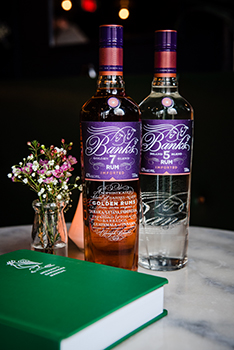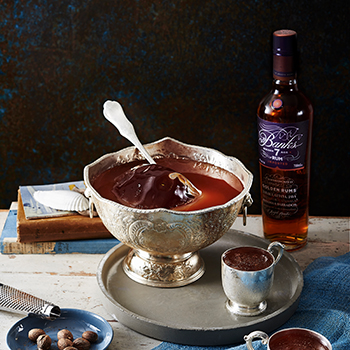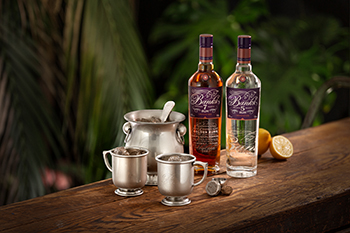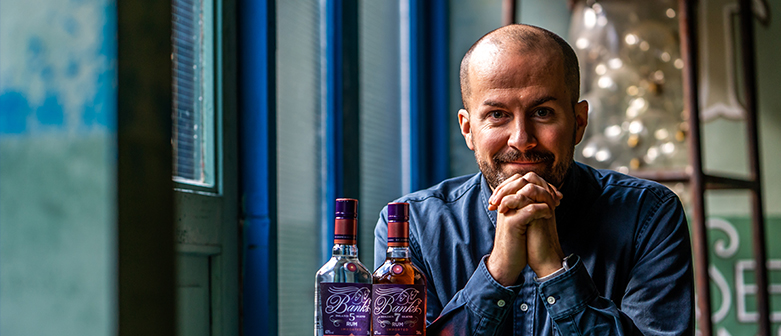Advertorial
We have a wide-ranging chat with a man we once described as having more hats than Mr Benn and having now seen his living room, I think he also has more books than the British Library.
In March this year, it had been 10 years since Banks 7 Golden Age Blend launched in the UK. Back then there was a swanky event at the OXO Tower with the two men responsible for the blend, Jim Meehan and Arnaud de Trabuc, in attendance, providing tastings and cocktails. It was a really good day, and we decided this was a good enough excuse to catch up with Jim for a chat.
It was of course over Zoom, as is the way of the world, but we didn’t let that stop us from putting the world to rights over a rum or two.
We doubt any of you reading this will not know of Jim Meehan, but you may not be aware of everything he has done in his career. In 2005 after a variety of hospitality jobs, he got himself a job at Audrey Saunders legendary Pegu Club as part of the opening team, and he was the last of the opening team to leave when he moved to focus on his bar, PDT (Please Don’t Tell) in 2007. PDT was one of the great New York bars! Two years after opening, Jim won American Bartender of the Year at Tales of the Cocktail and a couple more years on, published his first cocktail book The PDT Cocktail Book.
Not content with all of that (which sounds exhausting enough just writing it out), he teamed up with Arnaud de Trabuc to launch a rum.. Banks 5 Island Blend hit the back bars in 2010 and was followed by the aforementioned Banks 7 Golden Blend. Since then he has published another book or two, opened more bars including his current project Takibi in Portland, travelled the world inspiring bartenders and continued to spread the story of Banks Rums.
We covered many topics in our chat from the demise of the punch bowl to Danny DeVito, from David Wondrich’s 4th of July parties, to what tonic water has to answer for. We kick off with Banks 5 Island Blend and the Daiquiri, however, I feel it is right to mention we had a long chat before that about the exodus of leadership in our industry following Covid. It was a fascinating chat but one that deserves more time than this article can give it, so one we will be revisiting in another article soon.
Right over to Jim!
BLUK: We know that the Daiquiri was important to you when launching Banks 5 Island Blend but it wasn’t what people expected from a white rum back in those days?
Jim Meehan: Yeah, back in 2010, David Cordoba, the then Bacardi Global Brand Ambassador, and Simon Difford were in London doing lots of work with the Daiquiri. David was looking at the traditional recipe using granulated sugar, and he made a great Daiquiri. Simon was focusing on the mouthfeel and the sugar syrup ratios. Both were focusing on the sugar and the sweet/sour balance rather than the rum. So, Banks Rums came in saying ‘Hey what if a Daiquiri tasted of rum rather than limeade?’
We’re going back 12 years here, when it was somewhat revolutionary for the white rum to be featured, instead of a decanter of premium spirit. It was also a time where the idea of a premium white rum was an oxymoron. People only thought of white rum as a vehicle to make loads of profit in their bars, so that was one of the biggest things I had to push back on.
BLUK: Do you think this is something that has changed in the last 12 years?
Jim: I think that in many ways my biggest concern 12 years ago was, and remains, that buyers don’t consider Banks Rums because of its price, and they look for something cheaper instead, because rum should be cheap in their mind.
Bacardi has played a pivotal role discrediting this notion by releasing rums previously held back for family members such as Facundo, and launching line extensions like Bacardi White Heritage Blend, which was a game changer for me. Since acquiring Banks and Leblon, Bacardi’s formed a portfolio of premium rums that showcase different styles and production traditions, with Santa Teresa as its newest addition. By embracing quality and character instead of flavours and other gimmicks in the category, Bacardi’s helped put rum on an equal footing with whisky and brandy, which is huge.
I think the biggest change we’ve seen across all spirits is the world falling deeper in love with tequila with people like you and I getting more and more interested in other agave spirits like mezcal. I think we’ve seen a sort of “mezcal-ification” of our industry that’s lined ups with the craft distilling boom. The downside is that instead of spending time talking about what we do with spirits, as in sip them, make cocktails with them, make cake with them, you know, whatever; everyone wants to get under the hood to discuss very specific production orientated technical things instead of functional matters.
BLUK: Do you think consumer’s palates have changed as well, they used to want the neutrality of vodka and now it is the botanicals of gin that is craved?
Jim: I remember when Pegu Club opened in 2005, we didn’t have a vodka drink on the menu and people would come in and say, ‘Can I have a Whiskey Smash, but made with vodka?’ or ‘A Gin Gin Mule, but a Vodka Mule?’. They literally picked a drink, which they thought looked good, that was made with whiskey, tequila, gin or brandy and they’d be like ‘Can I have it with vodka?’. This was a thing back then; they asked with a straight face.
At that time, gin producers were coming to us, as Pegu Club had a gin focus, asking what they could do to help the Martini catch on, and we kept saying to them that the Martini wasn’t going to drive gin sales: the gin and tonic was. There were no good tonics, so we were pouring something similar to Sprite! I think it was actually tonic that changed the category, not gin. It was a tonic boom that changed the trajectory for gin. Fever-Tree started it off followed by other artisanal, craft dry tonics.
I think you can make a very coherent argument that while gin is the new vodka, it was tonic that drove it, and while mezcal is the new spirit of the time, the new zeitgeist spirit, perhaps it was the smokiness of the Penicillin and Oaxaca Old Fashioned, which weren’t Islay whisky or mezcal based, but were blended scotch and tequila drinks which had a hint of smoke to them. It got people thinking about smoke in drinks. So as a bartender who doesn’t make spirits but blends things together, I continue to try to push back on the conversation to be ‘Hey, the way that we blend to create the flavour profiles is what’s driving taste; not just the spirits and the production methods alone.’
BLUK: Looking at blending flavours I know that punch has long been a passion of yours and has always been strongly linked to Banks, why is that?
Jim: When I started on my Banks Rums journey, I had an advance copy of David Wondrich’s book, Punch [The Delights (and Dangers) of the Flowing Bowl] which talks about how the history of the cocktail started with punches, and arrack is mentioned dozens of times. I realised that arrack was akin to the premier punch ingredient of the 19thcentury. That clued me in to the idea that then, in the late 2000’s, the speakeasy movement was really sort of gaining steam and I had a sense that if the drinks fashions were going to continue to go backwards, instead of forwards, it would only be a matter of time until people started getting into punch.
Death & Co. put a punch on their opening menu, Drink in Boston served punch upon arrival to everyone, then the Dead Rabbit followed suit. Over in London, Nick Strangeway championed classic punch service at the Hawksmoor and then Hix. I believed it was inevitable that it would become popular because, as you know (and some people may not want to hear) the drinks business is the fashion business. So, it’s not a matter of if, but when.
BLUK: I’ve noticed in recent times you have moved away from the large serving vessel style of punch service and into more single serve versions.
Jim: I always anticipated that the best way to alleviate pressure on busy bars, instead of cocktails on tap, or bottled cocktails, which I find antithetical to our whole ethos, would be to serve punch; either with a ladle by the cup, or if you are working in a busy high-end venue, you could potentially sell it by the bowl. It would be expensive, but it’s doable, and beats bottle service if you ask me?
When I opened Prairie School, my short-lived dream bar in Chicago, I put a single serve punch on the menu. I didn’t call it a punch, but it was a punch based on its ingredients and their proportions. When I opened Takibi, I created a variation upon my Green Tea Punch with the Banks 5 infused with nori. It’s been hugely popular, as punch falls in with trendy, lower ABV, sessionable drinks that are trendy these days.
Earlier, I was talking about how tonic drove gin sales; and I should add that the vessels that we drink out of, are also incredibly important. When I used to live in New York, I remember David Wondrich used to have a 4th July party each year and he would serve punch out of a Gatorade bucket in his backyard. It was functional because it was hot back there, and a pewter punch bowl would have been a bad idea in the Brooklyn sun. I think there’s still someone out there, who’s yet to discover the perfect vessel for punch and once we get there I’m still bullish on this proposition.
BLUK: Well, it’s been 10 years since the last Banks Rums product was launched and it would be remise of me not to ask the question everyone probably asks you, is there any new Banks Rums expressions coming?
Jim: We’d won best new product at Tales of the Cocktail with the Banks 5 Island Blend, so there was a lot of pressure for the next line extension before the Banks 7 Island Blend came out. The fact is, I was tired of talking about arrack after two years (instead of the art of blending in general) with Banks 5 Island, but the distinguishing thing about Banks Rums was the addition of a rum from the East to the usual West Indian rums. When we started the blending process for Banks 7 with Arnaud, we wanted to find another rum from the East and we tasted dozens and dozens of rums but all the ones we liked had arrack in them! The one we both liked best had the same five original as Banks 5 Island Blend, with the addition of Panama and Guatemala. I always like to mention that these rums exist not because we were trying to create a 5 origin or 7 origin rum but because we liked the way they tasted together.
In the last 8 years there’s been this sort of, oh look what they’re doing over there FOMO, because, as you know, I like rum. So there has definitely been some jealousy over the years but, having gotten older and thought a lot about this, I find it pretty exciting that we can do an entire tasting of Banks Rums with just two bottles. These aren’t spirits driven by the production methods but by what you can do with them.
Arnaud and I were an odd couple: he, a French count, and I, a young American mixologist. It was kind of like Arnold Schwarzenegger and Danny Devito: I’ll let the reader decide who was who? He wanted to sip them, and I wanted to mix them. We used to say, ‘A pity to mix and a shame not to’. I think that the legacy of Banks Rums is that we’ve created a rum, 10, 12 years later, that works in the Cuban Canon of recipes including your Daiquiri, that works in a tropical drink including your Mai Tai, and that makes a perfect 19th century style punch.
While I would love our line extensions to be part of the story of Banks Rums, I’m proud of what we’ve accomplished. I’m not sure what the future holds, but I do know that what we’re focused on now is showing what you can do with the two rums we have. When we talk about blending, we talk about the idea of bringing in rums from multiple origins – it’s a model for gathering people from multiple walks of life, from multiple places. So hopefully in the coming years, we’re going to use our platform to talk about community and gathering, how we gather round a punch bowl or around a cocktail.
Well doesn’t that seem like a lovely note to end on, especially in this moment in time. It was an absolute joy to catch up again with Jim, not quite the same over Zoom, but certainly better than nothing. I hope you enjoyed reading his thoughts? There were so many more we didn’t have time to put in there, but keep an eye out for a cocktail competition pitting Dale DeGroff, Peter Dorelli and Salvatore Calabrese against each other: it is one of our better ideas.
Also, if you don’t already, follow both Banks Rums and Jim on Instagram, both have some great content.


